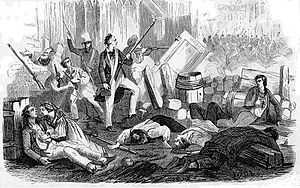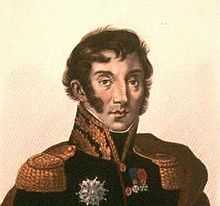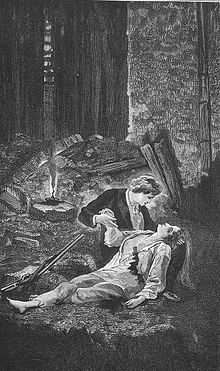June Rebellion
| June Rebellion | |||||||
|---|---|---|---|---|---|---|---|
 An 1870 illustration depicting the rebellion | |||||||
| |||||||
| Belligerents | |||||||
|
| |||||||
| Commanders and leaders | |||||||
|
| |||||||
| Strength | |||||||
| 30,000 | 3,000 | ||||||
| Casualties and losses | |||||||
| 73 killed, 344 wounded[1] | 93 killed, 291 wounded[1] | ||||||
The June Rebellion, or the Paris Uprising of 1832 (French: Insurrection républicaine à Paris en juin 1832), was an unsuccessful, anti-monarchist insurrection of Parisian republicans, June 5-6, 1832.
The rebellion originated in an attempt of the republicans to reverse the establishment in 1830 of the July Monarchy of Louis-Philippe, shortly after the death of the king's powerful supporter, President of the Council, Casimir Pierre Périer, on May 16, 1832. The death of Jean Maximilien Lamarque was a spark shortly before the revolutionaries rose to their barricades. The rebellion was the last outbreak of violence linked with the July Revolution.
Author Victor Hugo described the rebellion in his novel Les Misérables, and it also figures largely in the stage musical and films based on the book.
Background
In the 1830 July Revolution, the elected Chamber of Deputies had established a constitutional monarchy and replaced Charles X of the House of Bourbon by the more liberal Louis-Philippe. This angered republicans who saw one king replaced by another. By 1832 there were "simmering discontents, especially strong among republicans, who felt that they had spilled their blood on the 1830 barricades, only to have their revolution 'stolen' by a coterie of opportunists who managed to get Louis-Philippe crowned king".[2] There was also discontent from Bonapartists, who lamented the loss of Napoleon's empire, and by the Legitimists, who supported the deposed Bourbon dynasty, and sought to place the "true" king, Charles's designated successor Henri, Count of Chambord, in power.
Causes and catalysts

Leading up to the rebellion, there were significant economic problems, particularly acute in the period from 1827 to 1832; the years were marked by harvest failures, food shortages, and increases in the cost of living, creating discontent throughout the classes.[3] Additionally, the spring of 1832 saw Paris ravaged by a Europe-wide outbreak of cholera, which ended with a death toll of 18,402 in the city. The poor neighborhoods were particularly devastated by the disease, arousing suspicion of the government poisoning wells.[3] The epidemic soon claimed two famous victims. The Prime Minister Casimir Perier fell sick and died on May 16, and the Napoleonic General and liberal politician Jean Maximilien Lamarque died on June 1. The conservative Perier had been given a grand state funeral. Accordingly the funeral of the popular Lamarque, who had shown sympathy toward the lower class, was seen as an opportunity to demonstrate the strength of the opposition.[3]
The monarchy of Louis Philippe, which had become the government of the middle class, was now attacked from two opposite sides at once.[4] Before these two deaths, there had been two significant rebellions. In France's second city, Lyon, a workers' uprising known as the Canut revolt, caused by economic hardships, had occurred in December 1831. Troops had been sent to pacify the area after members of the local National Guard defected to the rebels.[5] In February 1832 supporters of the Bourbons—the Legitimists, or Carlists as they were called by their adversaries—made an attempt to carry off the royal family in Paris in what become known as the "conspiracy of rue des Prouvaires".[4] This was followed by an insurrection in the Bourbon heartland of the Vendée led by Caroline, Duchess of Berry, mother of Henri, Count of Chambord, the Legitimist claimant to the throne as "Henri V". The duchess was eventually captured in late 1832 and imprisoned until 1833. Following this failure the Legitimists renounced war and fell back on the press as a weapon.[4][6]
Insurrection
The republicans were led by secret societies formed of the most determined members of their movement.[4] The secret societies planned to provoke riots similar to those that had led to the 1830 July Revolution against the ministers of Charles X.[4] The "Society of the Rights of Man " was one of the most instrumental. It was organized like an army, divided into sections of twenty members each (to evade the law that forbade the association of more than twenty persons), with a president and vice president for each section.[4]
The republicans made their move at the public funeral of the popular General Lamarque on June 5. Groups of demonstrators took charge of the cortege and directed it to the Place de la Bastille. They were reinforced by Polish, Italian, and German refugees, who had fled to Paris in the aftermath of crackdowns on republican and nationalist activities in their homelands, as well as by workers and local youth. They gathered around the catafalque on which the body rested. Speeches were made about Lamarque's support for Polish and Italian liberty, of which he had been a strong advocate in the months before his death. When a member of the crowd waved a red flag bearing the words "Liberty or Death" (in french), the crowd broke into disorder and shots were exchanged with government troops.[2] The Marquis de Lafayette, who had given a speech in praise of Lamarque, called for calm, but the outbreak spread.[7]
The subsequent uprising made the approximately 3,000 insurgents masters of much of the eastern and central districts of Paris for one night; between the Chatelet, the Arsenal and the Faubourg Saint-Antoine. Cries were heard that the rioters would sup at the Tuileries Palace that evening.[8] However, the rebellion failed to spread. During the night the 20,000 part-time militia of the Paris national guard were reinforced by about 40,000 regular army troops under the command of Marshal de Lobau, who pacified the peripheral districts of the capital. The insurgents made their stronghold in the Faubourg Saint-Martin, in the historic city center. They constructed barricades in the narrow streets around the Rue Saint-Martin and Rue Saint-Denis. On the morning of June 6 the last rebels were surrounded at the intersection of rue Saint-Martin and Saint-Merry. At this point Louis-Philippe decided to show himself in the streets to confirm that he was still in control of the capital.[9] Returning to Paris from Saint Cloud he met with his ministers and generals at the Tuileries to declare a state of siege, before riding through the area affected by the rising, to the applause of national guards and soldiers. The final struggle came at the Cloître Saint-Merry,[4] where fighting continued until the early evening of June 6. Total casualties in the rising were about 800. The army and national guard lost 73 killed and 344 wounded; on the insurgent side there were 93 killed and 291 wounded.[1] The forces of the insurrection were spent.[6]
After-effects
The government portrayed the rebels as an extremist minority. Louis-Philippe had shown more energy and personal courage than his Bourbon predecessor Charles X had during the July Revolution two years before. [10] When the king appeared in public his supporters greeted him with cheers. General Sébastini, the Foreign Minister, who directed government forces, stated that local citizens caught up in events congratulated him: "they accepted us with cries of Vive le Roi and Vive la liberté, showing their joy at the success we had just obtained".[9] Subsequent identification of rebels revealed that most (66%) were working class, a high proportion being construction workers. Most others (34%) were shopkeepers or clerks.[9]
A large number of weapons were confiscated in later raids, and there were fears that military law would be imposed. The government which had come to power in a revolution distanced itself from its own revolutionary past, most famously removing from view Delacroix's painting Liberty Leading the People, which had been commissioned to commemorate the events of 1830. According to Albert Boime, "after the uprising at the funeral of Lamarque in June 1832 it was never again openly displayed for fear of setting a bad example."[11] A man named Michael Geoffroy was charged with starting the rebellion by waving the red flag. He was initially sentenced to death, but a series of legal manoeuvres led to much reduced prison sentence. Later trials led to some other death sentences, but all were commuted.
Several rebels took the opportunity to deliver republican speeches at their trial. Republicans used the trials to build support for their cause, emphasising the trial of Charles Jeanne, one of the leaders who proudly defended his actions. He was convicted and imprisoned, becoming a republican martyr after dying in prison in 1837.[9] A pamphlet published in 1836 compared the defeat of the republicans to the heroic resistance of the 300 Spartans at the Battle of Thermopylae.[3]
A republican, is virtue, perseverance; is devotion personified...[he] is Leonidas dying at Thermopylae, at the head of his 300 Spartans; he is also the 72 heroes who defended during 48 hours the approaches of the Cloître Saint-Merry, from 60,000 men, and who… threw themselves onto bayonets to obtain a glorious death.[3]
Louis-Philippe's regime was finally overthrown in the French Revolution of 1848, though the subsequent French Second Republic was short-lived. During the 1848 Revolution, Friedrich Engels published a retrospective article called The June Revolution: The Course of the Paris Uprising, in which he analyzed the tactical errors which led to the failure of the 1832 uprising, and drew lessons for the 1848 revolt. The main strategic deficit, he argued, was the failure to march immediately on the town hall.
Hugo and Les Misérables

On June 5, 1832, Victor Hugo was writing a play in the Tuileries Gardens when he heard the sound of gunfire from the direction of Les Halles. The Gardens were deserted and the park-keeper had to unlock the gates to let Hugo out, but instead of hurrying home, he followed the sounds through the empty streets, unaware that half of Paris had already fallen to the mob. All about Les Halles were barricades. Hugo headed north up the Rue Montmartre, then turned right onto the Passage du Saumon, and at last turning before the Rue du Bout du Monde (World’s End Street). Halfway down the alley, the grilles at either end were slammed shut. Hugo was surrounded by barricades and flung himself against a wall, as all the shops and stores had been closed for some time. He found shelter between some columns. For a quarter of an hour, bullets flew both ways.[12]
In his later novel Les Misérables, first published in 1862, Hugo depicts the period leading up to the rebellion, and follows the lives and interactions of several characters over a twenty-year period. The novel begins in the year of Napoleon Bonaparte's final defeat and climaxes with the battles of the June Rebellion. An outspoken republican activist in the 19th century, Hugo unquestionably favored the revolutionaries.[13]
Scenes of Parisian students and the poor, planning the rebellion upon the eve of the benevolent General Lamarque’s death, are portrayed in the novel through the activities of the fictional "Friends of the ABC" (a pun on the French term abaissé, or "oppressed"), led by the charismatic character Enjolras and portrayed as a sub-group of the Rights of Man Society. The erection of barricades throughout Paris's narrow streets is also described. The ABC organize the building of a barricade in the Rue de la Chanvrerie, a side-road running into the Rue Saint-Denis, near a wine shop which they use as their base of operations. During the climactic battle the main characters all come together and many of them are killed.
Although a fictional work, Les Misérables has given the relatively little-discussed rebellion widespread renown. The novel is one of the few works of literature that discusses the June Rebellion and the events leading up to it.[14]
References
- ↑ 1.0 1.1 1.2 William Duckett (dir.) Dictionnaire de la conversation et de la lecture, Tome XI, p.702.
- ↑ 2.0 2.1 Mark Traugott, The Insurgent Barricade, University of California Press, 2010, pp.4-5.
- ↑ 3.0 3.1 3.2 3.3 3.4 Harsin, Jill. Barricades: The War of the Streets in Revolutionary Paris, 1830–1848. New York: Palgrave, 2002.
- ↑ 4.0 4.1 4.2 4.3 4.4 4.5 4.6 Seignobos, Charles. A Political History of Europe, Since 1814. New York: Henry Holt and Company, 1900.
- ↑ Guy Antonetti, Louis-Philippe, Paris, Librairie Arthème Fayard, 2002, p.673f.
- ↑ 6.0 6.1 Cobban, Alfred. A History of Modern France. Vol. 2. Harmondsworth, Middlesex: Penguin Books Ltd, 1961.
- ↑ Memoirs of General Lafayette and of the French revolution of 1830, Volume 2, R. Bentley, 1832, p.393.
- ↑ Philip Mansel, page 285 "Paris Between Empires - Monarchy and Revolution 1814-1852, ISBN 0-312-30857-4
- ↑ 9.0 9.1 9.2 9.3 Jill Harsin, Barricades: The War of the Streets in Revolutionary Paris, 1830-1848, Palgrave Macmillan, 2002 p.60.
- ↑ Philip Mansel, page 285 "Paris Between Empires - Monarchy and Revolution 1814-1852, ISBN 0-312-30857-4
- ↑ Albert Boime, Art in an Age of Civil Struggle, 1848-1871, University of Chicago Press, Chicago, 2007, p.16
- ↑ Graham, Robb (1998). Victor Hugo: A Biography. W.W. Norton and Company.
- ↑ http://www.online-literature.com/victor_hugo/les_miserables/
- ↑ Godfrey, Elton. The Revolutionary Idea in France. Second Edition. London: Edward Arnold & Co., 1923.